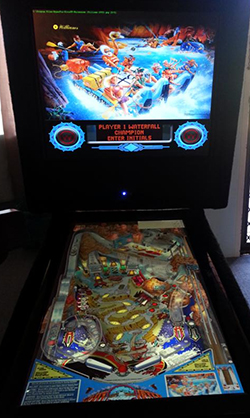 Hang around Hackaday long enough and you’ll hear about MAME, and all the other ways to emulate vintage arcade machines on a computer. The builds are usually fantastic, with real arcade buttons, MDF cabinets, and side graphics with just the right retro flair to make any connoisseur of ancient video games happy. MAME is only emulating old video games, though, and not physical systems like the digital pinball system [ronnied] put up on the Projects site.
Hang around Hackaday long enough and you’ll hear about MAME, and all the other ways to emulate vintage arcade machines on a computer. The builds are usually fantastic, with real arcade buttons, MDF cabinets, and side graphics with just the right retro flair to make any connoisseur of ancient video games happy. MAME is only emulating old video games, though, and not physical systems like the digital pinball system [ronnied] put up on the Projects site.
[ronnied] was inspired by a real life, full-size White Water pinball machine at his previous job, and decided it was high time for him to acquire – somehow – a pinball machine of his own. He had a spare computer sitting around, an old 16:9 monitor for the main playfield, and was donated a smaller 4:3 monitor for the backglass. With an MDF cabinet, PinMAME, and a little bit of work, [ronnied] had his own machine capable of recreating hundreds of classic machines.
The build didn’t stop at just a few arcade buttons and a screen; [ronnied] added a 3-axis accelerometer for a tilt mechanism, solenoids and a plunger torn from a real pinball machine for a more realistic interface, and a Williams knocker for a very loud bit of haptic feedback. We’ve seen solenoids, buzzers, and knockers in pinball emulators before, and the vibrations and buzzing that comes with these electromechanical add ons make all the difference; without them, it’s pretty much the same as playing a pinball emulator on a computer. With them, it’s pretty easy to convince yourself you’re playing a real machine.
Videos of the mechanisms below.















I have to applaud the work here and also being able to make past games available to those unable to find or afford them. Great work.
however the pinball snob inside me hates this ;)
This is exactly what I imagined years ago.
So freaking killer cool!
I wonder if a 3d monitor for the playfield would make things even more fun? Seems like a good application of the tech.
CastAR could make that quite fun. The glass would just be the mat. Ditto for the backglass.
I wonder if you could enhance this visually with multiple monitors the way they do slot machines these days. What you do is you have two LCDs on top of eachother seperated by a lexan (or other transparent panel) spacer. Then you have some powerful LEDs on the edge of the lexan to let you light up the front LCD so you can actually get a display. This still leaves it unable to produce whites and it’ll be transparent colors so you have the bottom LCD display white to compensate for the front LCD having no real back panel. You could do this with three monitors and possibly have a really kick ass looking pinball cabinet that has some real depth to it. you wouldn’t be able to display vertical surfaces but you could probably make it look nice still. I think a thin barrier would help even more too so the change in depth isn’t as significant.